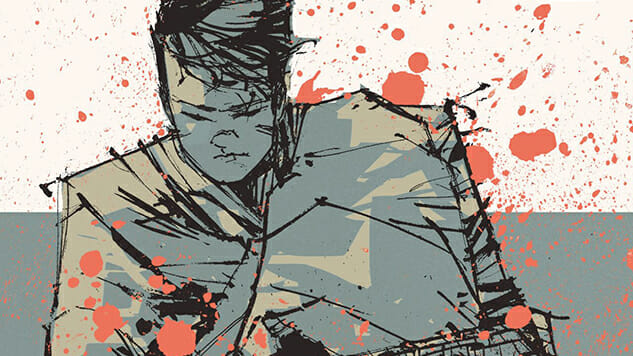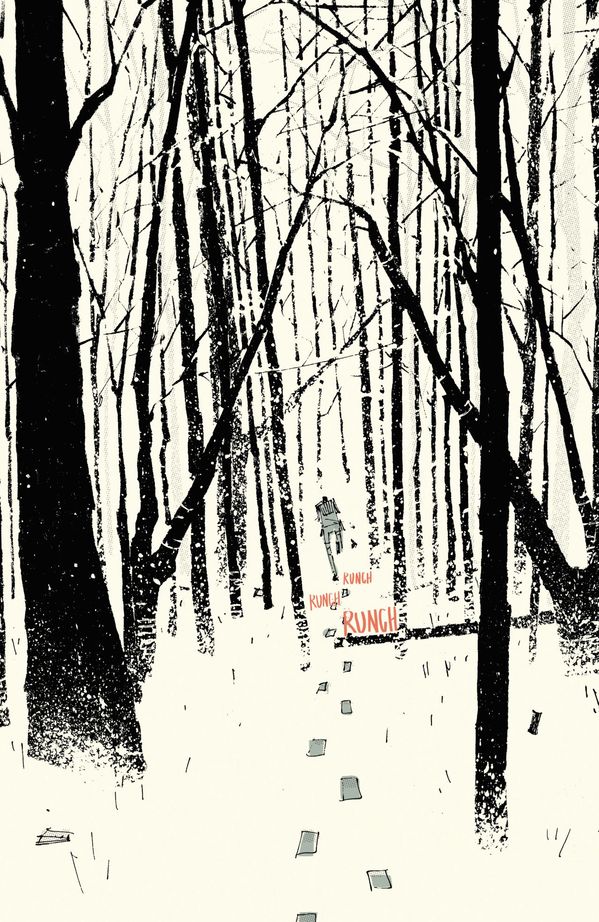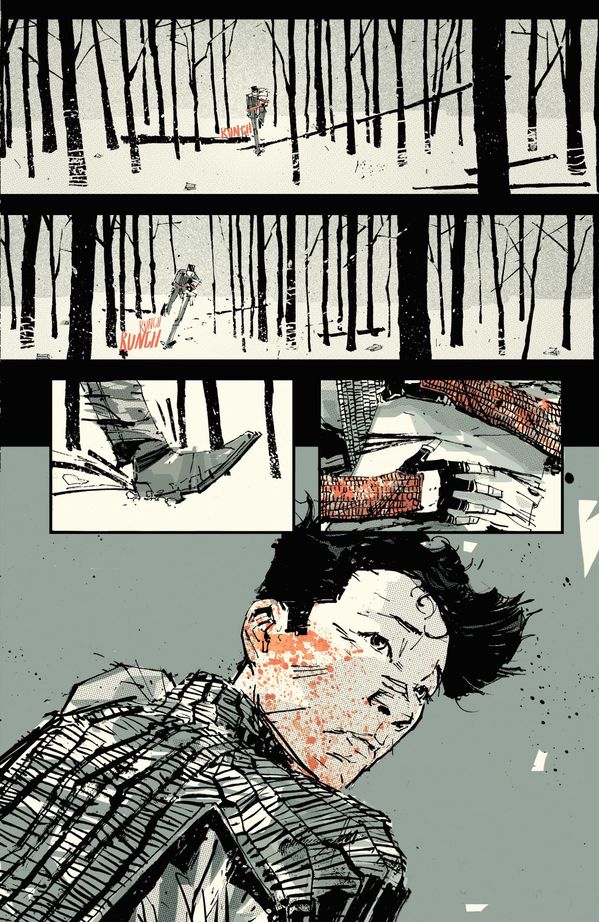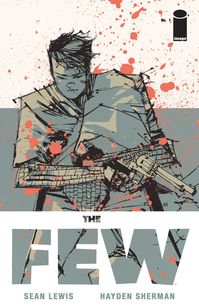Collaboration, Fanaticism & Historical Memory: Talking The Few With Sean Lewis
Cover Art by Hayden Sherman Comics Features Sean Lewis
The opening scene of The Few, the new Image series from writer Sean Lewis and artist Hayden Sherman, begins in silence and mystery, with a young woman traveling through a stark landscape in the near future with a baby in tow. What’s the nature of the authoritarian society she flees? Who are the people she encounters in the woods? And what are the voices from her past that still literally haunt her?
From discussing the new comic with Lewis, these questions are the point of the new epic, whose oversized debut issue releases today. With The Few, Lewis draws on his background in theater, allowing the medium’s concentration on dialogue on interpersonal relationship to flavor his take on sequential art. This is also the story of a future America where a perfect storm of polarization and fanaticism have reshaped society along terrifying lines. We spoke with Lewis about the process of making The Few, how his theatrical collaborations have shaped his work in comics and additional projects loom in the distance. ![]()
Paste: The first issue of The Few opens with an epigraph from Ursula K. Le Guin. She’s known for writing thoughtful science fiction that explores big societal and ethical issues. Was her fiction an influence on this series?
Sean Lewis: I came across the quotation a little later. Hayden and I had been talking about the possibility of using epigraphs to get into the book. That was one that spoke to Hayden pretty strongly. I had been thinking about the book for a little while before I met Hayden. I’m a New Yorker who’s transplanted to the Midwest, so very dark, gloomy winters are very much in my brain on a regular basis. I’m back and forth between New York and Iowa a lot, and they’re such different worlds. The opinions of each place on the other are so divisive. I was really fascinated by this bridge.
It was before the election had kicked off to the degree that it has. It’s been fascinating, how questions around the book have shifted since the election. One of my big fascinations is belief. One of the things I was looking at is how do people come to believe what they do? With Saints, that was something I was exploring, as far as the spiritual realm. With this book, it moves more into what people believe politically and philosophically. More than the quote, those were the things that were swinging around in my head at the start of the creation of the book.
Paste: In the first issue, there are references to a character named Herod, which sounds like you’re tapping into some religious imagery as well.
Lewis: The old Catholic school boy that I am, I can’t seem to shake religious imagery, as much as I try. The nuns literally beat it into me. I’ve been fascinated for a little while with groups like ISIS, and how, in the middle of the Middle East where communities are more spread out, there’s a lot more isolation. In that kind of setup, you’ll see fundamentalism—primarily religious fundamentalism—grow. For some reason, people gravitate towards leaders who the rest of the world might see as maniacal and savage. But when they’re on the ground level, preaching that this has to do with God, and that they have a higher purpose in what they’re doing, people will align themselves to that quickly.
I was thinking about what would happen if the Midwest and the South were basically cut off from the rest of the United States, from the East Coast and the West Coast: “You guys keep talking about secession and how you want to be separate? Well, we’re just going to walk away from you.” A lot of those regions are heavily religious, and I could see how, in those places, ISIS-like groups or fanatical religious-based leaders could get a foothold, and also have a reasoning and logic behind having more severe and savage methods.
Paste: There’s one point in the first issue where two characters are talking about Halloween. One doesn’t know what it is, and one remembers it as something that happened in the distant past. How much of The Few’s history did you have in mind before you sat down to write it?
Lewis: A lot of times when I’m developing a book, I approach it the same way as I’d approach writing plays. I usually write really long short stories, where I discover the plot and the characters. Then I’ll spend a lot of time writing journal entries for the characters, trying to get a better understanding of who they are and where I am in the world. It’s rare that I’ll sit down and think, Oh! This happened 1,000 years in the future, or 200 years in the future or last week. I have to write a lot of material before I can get to what I think the story is actually going to be about.
The Halloween thing came from the personal character journaling. These guys have been out in the woods for so long, and Davey’s 13 years old, so the idea of some of these ceremonies and things that people would not have time for anymore would be a kind of legend to him. I’m interested in these different narratives where you have people with a memory of an older world, or a time when it was better or a bit more unified. And then there’s the next generation, that’s growing up without any of those things. Halloween’s a big holiday for me, and I thought about how foreign and weird it would be to try to explain that to someone who had never heard of it. “We dress up like goblins to try to scare away goblins! But there’s also a religious element!”
It’s an interesting thing: what are the people striving for? There’s a character we’ll meet later on who’s Davey’s father, someone who grew up, and still remembers, when things were more unified. He’s striving for a world that he actively remembers. But then you have a kid like Davey, who’s striving for something imaginary; something that people have told him things were like, but that he’s never experienced himself. As a writer, that gives me a couple of different paths I can go on in terms of ideologies and motivations, as well as conflicts. How long can you fight for something that you’ve never experienced? And if you are going to keep fighting for something you never experienced, why are you doing that?

The Few #1 Interior Art by Hayden Sherman
Paste: There was a meme floating around on Twitter recently about things that you can remember from your childhood that you don’t think a teenager today would believe.
Lewis: I was thinking about this the other day. I work in theater a lot, so my actors are always completely connected to their phones. When I went to high school, there was no internet—it existed, but nobody had it. Sometimes I go in and teach acting workshops with people. There was a point when I was young enough where I was the hip acting teacher, and I would come in and use Reservoir Dogs or Pulp Fiction as an example of a scene: “It’s like that moment where he’s torturing that guy, and he cuts his ear…” It got to a certain point then people would say, “I was not even born when that movie came out.” All of my references to these things that had a huge impact on me didn’t even exist to them. You can search them out, but they’re not real to you. It was such a weird thing, that literally every one of us goes through.
Paste: You’ve collaborated with artists when making comics, and with actors when working in the theater. Is there anything that you’ve found to be similar between those two kinds of collaboration?
Lewis: With theater, it’s so collaborative all the time. I’m directing a show right now, and I have a team of designers, plus the actors, plus the stage managers. It’s a lot of trust: I’m going to give an actor this note, and they’re going to bring in what I need tomorrow, and I’m going to help shape it. There’s a level of freedom in that. A lot of times, I’ll say, “In this scene, this is what I’m not getting from that, and this is what I need you to do for tomorrow.”
I work with artists in the same way. I know what I’m looking for in artists that I work with. With Hayden, the starkness of his lifework—immediately, I knew it fit the story I’d been thinking about. And when I saw his paneling, I thought, Oh, the action sequences will work so great, the definitive pacing and speed that he’s able to create in them. The artists I’ve worked with have seemed to enjoy the amount of freedom that they’ll get—it’s not as much of a dictation, panel by panel. But it’s still a collaboration in the same sense. We’re going back and forth, all the time. Even if I’m not sending scripts, we talk about what the panels and pages will be beforehand. A lot of times, I’m sending him blocks—something between a short story and a screenplay. When we get on the phone, we’ll talk this through, page by page: “This sounds like the right movement, and maybe this is a splash page.”
For me, it’s really important that the artist feels as much ownership of the book as I do. A lot of times, the artist will help inform me, which is something I’ve learned from actors. The theater has taught me a good humility, as far as knowing how the best idea works. I started as an actor, and I was in the room a lot of times with directors who were more interested in being geniuses than doing the best work. A lot of times, you’d be stuck in a show going, “There are some shitty ideas up here, but he wants them to be his ideas.” When I started directing theater, I thought I’m not going to do that. I was going to come up with a lot of ideas, but if someone had something better than me, I had to be smart enough to use that.
I try to use the same approach with the artists. They’re getting to know the characters as well. There are times when we’ll be talking about whether that fits that particular character. I talk about the characters in theater terms a lot. Theater is all about character and motivation. A lot of times, I talk to the artists and try to get the right look for the page or the pace of the story, and it’s the same kind of terminology.
Paste: Was there one particular story that you realized you wanted to tell in comics rather than on stage, or was it more of a gradual development?
Lewis: It was a complete accident. I grew up in love with comic books, but I had no idea how anyone got hired to write a comic book. Not just as a kid—up to my adult life. There were a couple of things that I would fantasize about writing, and a couple of times when I might have sent emails to Marvel asking how you applied. It seemed unattainable. I just didn’t understand it.
I was directing a play, and I had a graphic artist who was building projections for it. Every time he turned in drawings, they looked like these Silver Age Superman drawings. The two of us started talking about it; he was a big comic book fan, and I asked him if he had ever thought about making a comic book. This was Ben Mackey, who I ended up doing Saints with. We started talking about this idea. He had taught himself how to draw by working on a lot of religious iconography, and he loved the idea of “What if saints were superheroes?” I grew up deeply immersed in Catholicism, and it just seemed to match. We said, “Fuck it—let’s make a comic book. At the very least, we’ll just make it for ourselves, and it’ll be fun.” We made the first issue of it on our own, and I did a cold submission to Image. We got really lucky. [Image publisher] Eric Stephenson reached out to us, and that’s how Saints ended up getting published.
The Few was kind of the same way. I was wrapping up Saints, and I’d started writing The Few. I thought it might be a short story or a novella, and I came across some of Hayden Sherman’s portfolio art. It felt like such a complete match that I reached out to him: “Here! Read these stories! Do you think you’d be interested in doing a comic book?” Hayden said yes, and we went to work on making the issue. At that point, I had the connection with Image, so I sent the first issue—maybe two issues—over to Eric. Image decided to publish this, too.
Paste: The way that color is used in the first issue of The Few is very interesting, especially for the sound effects in the first sequence. Where did that idea come from?
Lewis: The sepia tone and that contrast was very much Hayden’s decision, as opposed to mine. It’s also very much in line with the portfolio work I’d seen. They had this kind of starkness; the line work was similar, and the way he was using color was very similar.
I tended to write a lot of sound effects in the stories that I was sending to him, and he would incorporate them. I really liked it. One of the things I’m really interested in with comics is how visual they are. Dialogue-wise, versus a play, it’s pretty spare. It’s a lot of world-building and using the visuals to communicate emotion. Sound effects were a nice way for us to interrupt that meditation. You’re living with a character for a little bit and, for a couple of panels, watching their movement and their facial responses to where they are in the world. And then, suddenly, there’s an incredibly loud sound that breaks that peace and quiet. I was excited about that in comic form. That’s something that works out of action in horror movies: you pace through the silence, and then you disrupt it, startle the audience, and force the character into action. It’s really interesting to use that within the comic book.
Paste: There are a lot of scenes in the first issue of characters looking out at landscapes or dwelling within landscapes. How did you arrive at the right kind of pacing to translate those moods into the medium?
Lewis: It’s probably a mash-up of all of the things that I personally love. I’m a big fan of indie and foreign films, but I also love Mad Max. So, when my action is happening, I want it to be fast and furious and immediately exciting, but I also love—and this is the theater in me—to live with characters and see why they do the things they do, and spend time with them.
In terms of how we put that into action, a lot of that is in the pacing of the scripts and the storylines. It’s a lot of us talking back and forth: “Okay, we’re going to speed it up in this moment. I need to draw the audience in, I need to start with some distance and create some ambiguity and then, when we get up close, this is the image that should strike them so that they’re asking questions: ‘A baby with a gas mask? What the fuck does that mean?’ We’ve drawn the audience in, and we’re going to bring in the character that’s haunting her and start to get some dialogue.”
How the text lays itself on the page is interesting to me. I would say that in a lot of first issues of books, because you’re getting brought into a world to begin with, there are a lot of narration boxes. I think readers have gotten very used to that. For this story, specifically, I was interested in whether we could pace the book out so that the audience was discovering things at the same time that the characters were. That’s also how theater works. You find out that the guy’s being cheated on by his lover at the exact same time that he does. It’s not narrated forward or backward. The reveal happens in front of you.
We spent a lot of time talking about how you use silence without losing your audience in a comic book. How can I work with Hayden so that the pictures and the world are so clear that I can go three panels or four panels or half a page without anyone saying anything, but you’re still seeing a lot of action, you’re still learning a lot about the characters? When they do speak, it ties it all together, or it brings in a shocking element. That, to me, is where you create the pace. I’m really particular about that. Although it’s a visual medium, it can get really easy to narrate through everything. I’m so in love with certain writers in the form that I’m really interested in how much further you can go with that.
There was a certain time when I fell out with reading comic books in adulthood. Then I picked up a copy of Essex County by Jeff Lemire. That book blew my fucking mind, because there were pages where no one said shit, but you’re never lost. The characters kept growing. It’s such a small story, but it has a huge resounding effect.
I think a lot of people are doing interesting things nowadays. Tom King uses narration, but he does it in a really fascinating and new way. It’s not to say that one’s better than the other. What I’m interested in exploring in stories is pace, is silence, is how much I can give you the story at the same time as the characters.

The Few #1 Interior Art by Hayden Sherman
Paste: Do you have a sense of what you want your next project in the medium to be?
Lewis: I’ve been working on a book for a little while called Coyotes with an artist named Caitlin Yarsky. She’s really fantastic; she’s coming out of the videogame world. It’s a mythical take on Juarez, Mexico. Women are disappearing, and this young girl is being groomed by the women in her village to be their champion and find out what’s happening. It’s funny—I’ve had two books that don’t use as much narration and have this much sparseness. Coyotes is a complete 180 from that. There’s a lot of narration, and it looks more like a storybook.
I’ve gotten completely addicted to the comic-book form. I’m constantly sitting down and trying to think about what I think would be a cool book. But I also feel so lucky to have the opportunity that I’m doing as much as I can to make sure that I feel good about a project before I bring an artist in. I just had a kid about a year ago, and I imagine him growing up, and want him to be insanely proud of the graphic novels I’ve written that are on the bookshelf, so that when he pulls them off, he goes, “This is cool, Dad.”
There’s a push-pull with that. Part of me wants to do 50 books right now, and there’s another part of me that says, “Just make this one amazing and start to develop the next one. Build a portfolio that’s like the guys you look up to.” Coyotes is the next one on the hopper. And me and Ben Mackey, who I worked on Saints with, have had this rural-America, backwoods of upstate New York and Ohio, type-of-story that we’ve just started putting together. It’s going to take a little time, but I’m definitely excited to tell some stories about where I grew up.
